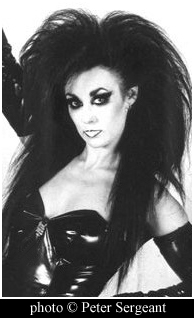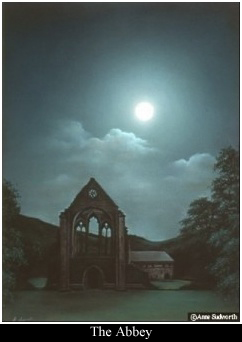Nicolas Cage, Academy Award winning actor on Anne Sudworth's work
|
Review of "Out of the Light", exhibition of Anne Sudworth's work.
Out of the Light, which was held at the modern SW1 Gallery in Victoria was a short but wonderful step in to the beautiful world and body of work she has created. Showing about 30 original pastels, we saw many breathtaking places throughout Britain presented in many different types of light (from sunlight to moonlight and the cloudy or different and veiled times in between - including sunrise and sunset). We visit Stonehenge, Tintagel in Cornwall where we come across (King) Arthur's Caste, Merlin's Cave and the coast (at Tintagel)l, St Nectan's Glen in Cornwall, various areas of the Lake District and more.
|
"Anne Sudworth is an artist aligned to the great European tradition of Dark Romanticism. She presents a re-visioning of our landscape, where the poet communes with enchanted phantoms, and is bathed in a mystical illumination in which the very soul of nature is revealed. She reminds us that it is the purpose of great art to express true and transcendent spirit." |
This is a beautifully presented book, the cover is striking, the pages are all edged with silver - this book really is something special. Prepare to have your breath taken away! There is page after page of the most beautiful paintings, in particular the ones of the trees and the moon caught my attention, I just wanted to climb inside the picture! With an uncanny knack of turning a beautiful scene into a mesmerising painting, she will stun you! There is also well-written text, which I eventually got round to reading, (the paintings completely absorbed me!). There are five chapters in all, which open with a brief passage about their titles such as "Darkness" and "Ruins". As the book closes there is a piece on the artist herself. This really was a pleasure to review, and I cannot rave enough about this book, it's stunning.
|
There's an old tale about
three blindfolded men who're asked to identify an elephant. The
first touches the tail and says the mystery object is a rope; the
second, grabbing a leg, asserts that the object is a tree; the third,
encountering the trunk, declares this is a serpent. The point of
the tale is that we're like the blindfolded men; although we can
see, we cannot see -- we recognise only a part of what is in front
of us, and on the basis of that we constantly misidentify and misunderstand
the totality. Some people are able
to see better than the rest of us. If they're then capable
of rendering their vision onto canvas or paper in such a
way -- whether abstract, surreal or mimetic -- that we,
too, can have at least a glimpse at what they see, then
we describe the person as a gifted artist: their works offer
windows onto a more profound, more insightful reality than
the one we are accustomed to. But the true artistry is,
arguably, that initial act of seeing; the technical rendition,
while of course extremely important, is secondary. |
21st Century Goth
The Goth Rock Book by Mick Mercer
The Hex Files
The Goth Rock Book by Mick Mercer
|
|
Excerpt from an interview for Cresent
Blues
Anne Sudworth: Light from the Earth
by Jean Marie Ward

The words "fantasy art" usually conjure images of battling barbarians, monstrous apparitions and decadent sorceresses enveloping both covers of a paperback book. You think in terms of "illustrations," not "paintings," and small canvases designed for reproduction and occasional display on the pegboard aisles of a science fiction convention art show. English artist Anne Sudworth defies these cliches on several levels. With very few exceptions, her voluptuous renderings of magical landscapes and legendary creatures tell no one's stories but her own. As at home in the reverent hush of an art gallery as in a cavernous convention art show, Sudworth's paintings use "Earth Light" to invoke the concentrated life force of the planet and strengthen the links between ancient myths and modern enchantments. Crescent Blues: What is Earth Light? Anne Sudworth: I think the best way to describe Earth Light is exactly that - "earth light" or light coming out of the Earth. It's interpreted in many ways, sometimes physical, sometimes spiritual but always as a symbol of the earth's energy and life-force. I have been told that the idea of Earth Light is a very ancient one.Crescent Blues: How did you develop this concept? Anne Sudworth: I've been influenced a great deal by the idea of this natural phenomena, this symbol of natural energy. In my work, Earth Light is an ongoing theme and one which I am continuing to explore. I like the idea that the Earth has a darker, lesser known side -- perhaps one of which our ancestors were more aware. I usually paint the Earth Light flowing from a particularly special tree, or perhaps a wood. For me this represents a concentration of the Earth's energy and power. Over the past few years it's become more and more a part of my painting. Crescent Blues: How does this relate to your feelings on the symbolic value of color? Anne Sudworth: Color is a very powerful thing, used symbolically or otherwise. I don't always choose a color because of its symbolic value. I tend to use colors which will create the mood or atmosphere I want in a piece of work. In some pieces though, the symbolic value is very important. I use certain greens for example in many of my paintings to do with death or the afterlife like The Path or Stay Not On the Precipice. Here the symbolic color plays a major part in the work.  Crescent Blues: What are the wellsprings of your
symbolism? Are the symbolic elements in your paintings deliberate
or do they arise naturally from the subject matter?
Crescent Blues: What are the wellsprings of your
symbolism? Are the symbolic elements in your paintings deliberate
or do they arise naturally from the subject matter?
Anne Sudworth: The symbolism in my work comes from all sorts of things. It's usually deliberate but probably done subconsciously as well. I draw on many things for my work, dreams: mysticism, nature.... There are many Celtic influences in my work too. Crescent Blues: Do you see the many paths in your paintings as real roads or spiritual journeys? How do you decide which is which? Anne Sudworth: Most of the paths in my paintings do symbolize spiritual journeys or are gateways to somewhere or something normally closed to us. Sometimes the paths are boundaries. There are very few paintings which depict real roads as most of my scenes and landscapes are imaginary. Crescent Blues: Are there any other landscapes you'd like to explore and paint? Anne Sudworth: I love seeing different landscapes and there are lots that I'd like to explore but I'm not sure I'd paint them. The landscapes that I paint are usually imaginary (though as I've said, these are sometimes based on real places). They are for me more than a pleasing scene to capture. The landscapes that I paint are more concerned with the mystical aspect rather than just the aesthetic one -- something which would perhaps take too long to explain. Crescent Blues: Your chosen medium is pastels. What prompted you to start working in this medium? Anne Sudworth: I used to work in all kinds of media, oil, watercolor, pencil and still do, occasionally. I started working in pastel some years ago when my mother bought a small box of artist's soft pastels for me. Since then I just can't seem to leave pastel alone. 
Crescent Blues: What technical challenges do working in pastels present an artist? Are there some textures that lend themselves to pastels more than others? How does this affect your choice of subject? (Or does it?) Anne Sudworth: Well, I think it's quite a messy medium and the dust can be a bit of a problem. It's also a very direct medium -- you don't need to add anything to it, or use any implement to apply it. (Pastel is basically pure pigment held together with a bit of gum.) My choice of medium doesn't affect my choice of subject at all. I think you should take the medium you choose and make it do whatever it is you want it to do. I don't think it should limit or dictate the choice of subject matter in any way. Crescent Blues: Family and friends frequently serve as your models. Do you have a favorite model? What makes that person such a joy to paint? Anne Sudworth: I don't really tend to paint people that often. (I think there are only about 12 paintings of people in the whole of the book on my work.) When I do paint figures I usually already have an idea of how I want the figure to look, so I try to find someone with similar characteristics to help get the anatomy right. Warren, my partner, is always a good model and has sat for me a number of times. He's always very patient no matter how long he has to sit and is also a good critic -- brutally honest. Crescent Blues: Do you have any special rituals related to your painting? For example, do you like to paint to music? If so, what kind? Anne Sudworth: I'm sure there must be lots of special things I do without noticing them. There is one thing that I always do, whenever I start a new piece of work I mark out a boundary in black or brown pastel. I almost always listen to music while I'm working. The kind of music depends on what mood I'm in and what I'm painting. I also have to be on my own. I just can't work with someone in the room (unless they are sitting for me or bringing me a supply of chocolate). When I'm working I become totally involved in the piece and tend to lock myself away. |
Enchanted World - The Art Of Anne Sudworth
Book review by -- David V.
Barrett, "Freelance Informer".
 "The best of this bunch, though, is "Enchanted World: The Art of - Anne Sudworth". Few of these [pictures] have been done for book covers; most are simply beautiful paintings, of Lake District scenes, trees, ruins, all with gorgeous skies, and the most incredible lighting I've ever seen in paintings. Think of ruins painted by John Martin, or those haunting Victorian street scenes by John Atkinson Grimshaw. The lighting in these paintings, magical, mystical, fantastical, suggests the land of faerie; it comes from the paintings themselves, from the moon, from the trees. Some of her paintings do have dragons, unicorns, faeries and other fantasy creatures; but it's the trees, the ruins, and above all the skies, which make these paintings so wonderful. Of all the art books I've reviewed in this column over the years, this is the one I would most want to buy as a special gift for a very special friend." |